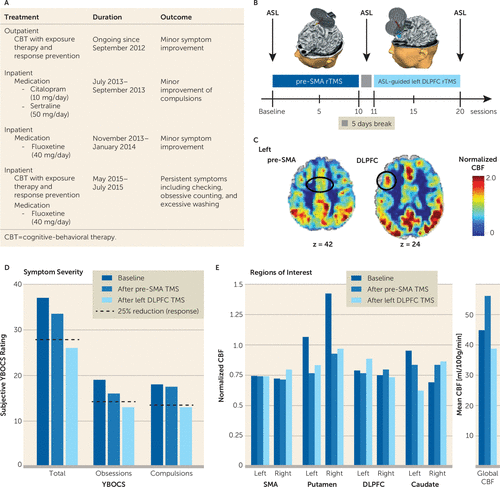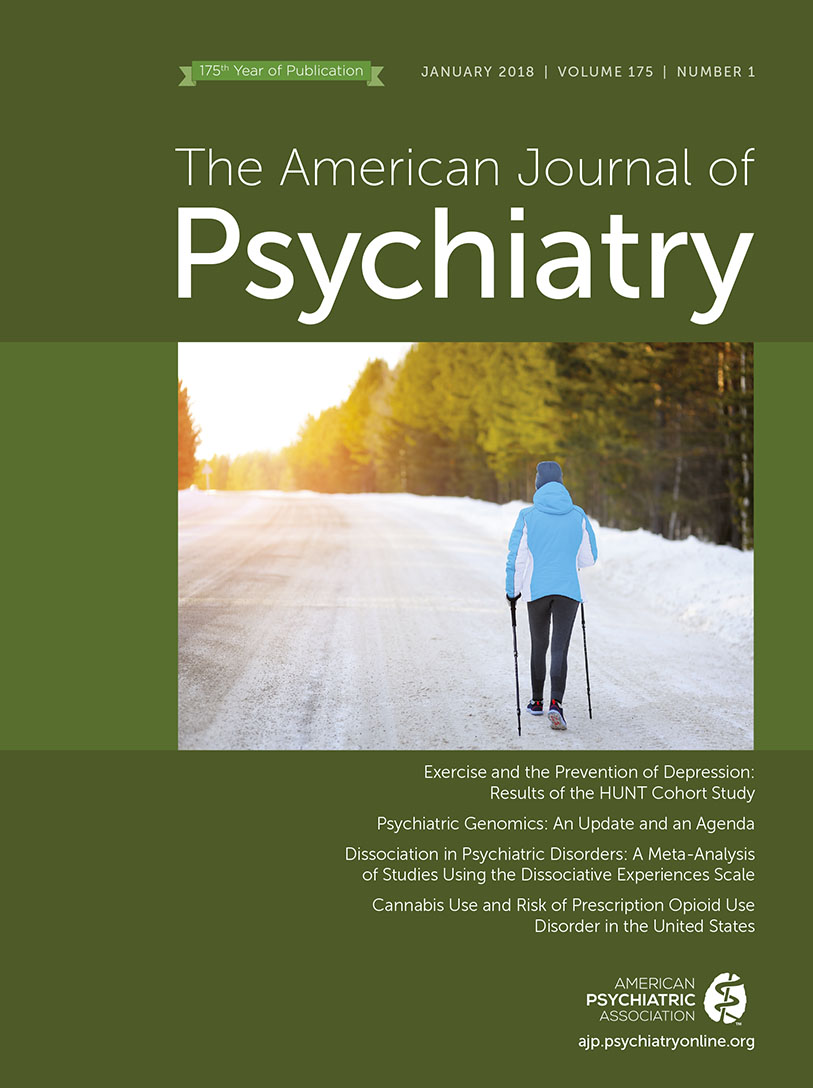Targeting Obsessive-Compulsive Symptoms With rTMS and Perfusion Imaging
To the Editor: In May 2015, a 27-year-old man was referred to our hospital because of treatment-resistant obsessive-compulsive disorder (OCD), from which he had suffered since age 12. He had undergone first-line treatment including cognitive-behavioral therapy together with different selective serotonin reuptake inhibitors (Figure 1A). However, despite adequate treatment dosages, OCD symptoms remained severe (Figure 1).

FIGURE 1. Effects of Repetitive Transcranial Magnetic Stimulation on Obsessive-Compulsive Symptoms and Cerebral Blood Flowa
a As shown in panel A, several first-line treatments failed to reduce symptoms of obsessive-compulsive disorder (OCD). As shown in panel B, we applied low-frequency repetitive transcranial magnetic stimulation (rTMS) over the bilateral presupplementary motor area once a day, 5 days per week for 2 weeks based on studies with promising results concerning OCD symptomatology. Panel C displays arterial spin labeling (ASL) measurements after presupplementary motor area rTMS revealed persistent hyperperfusion in the left dorsolateral prefrontal cortex (DLPFC) (Montreal Neurological Institute space). To focus on regional changes, we normalized cerebral blood flow (CBF) values by dividing them by the mean gray matter–corrected global CBF. As shown in panel D, symptom improvement was noted after the two rTMS treatments. As shown in panel E, assessments after left DLPFC rTMS revealed a more than 25% reduction of symptom severity (which is sometimes considered the clinical response criterion for the Yale-Brown Obsessive Compulsive Scale [YBOCS]) and CBF decrease especially in the left caudate nucleus, a part of the cortico-striato-thalamo-cortical circuitry. The slight regional CBF increase in the left DLPFC after rTMS over this particular area has been reported previously (1). One explanation for this potentially counterintuitive phenomenon is that the TMS-induced inhibition leads to a selective activity increase in inhibitory neurons that in turn causes the CBF increase under the coil, while activity in excitatory neurons decreases (1). SMA=supplementary motor area.
For augmentation purposes, repetitive transcranial magnetic stimulation (rTMS) has been suggested, although previous results concerning outcome, stimulation site, and TMS protocols have been inconsistent (2). In OCD, rTMS is administered to target cortical regions, such as the presupplementary motor area and the dorsolateral prefrontal cortex (DLPFC) (2), which are connected to hyperactive subcortical components of the cortico-striato-thalamo-cortical circuitry. Because most recent results of low-frequency rTMS over the presupplementary motor area have been promising (3), we stimulated this region for 10 sessions with a fluid-cooled 70-mm figure-8 coil and 1-Hz and 20-minute trains (1,200 pulses/day) at 100% of resting motor threshold. However, symptom reduction was only modest after the treatment (Figure 1D), and arterial spin labeling (ASL), a noninvasive neuroimaging technique that measures cerebral blood flow (CBF), revealed hyperperfusion in areas related to cortico-striato-thalamo-cortical circuitry such as the left DLPFC after rTMS of the presupplementary motor area. Therefore, another 10 sessions of rTMS were applied over the left DLPFC, a target region that also has shown promise in previous studies but has never been targeted using ASL-guided neuronavigation (2). In a second treatment series, we thus used ASL-guided rTMS over the left DLPFC allowing optimal localization and online monitoring of the coil’s position, applying the same stimulation parameters as in our first treatment. Medication remained stable the 2 weeks before and during the intervention. Assessment following left DLPFC rTMS showed a more convincing clinical reduction on the Yale-Brown Obsessive Compulsive Scale and CBF decrease in the left caudate nucleus, which is structurally connected to the left DLPFC. This result suggests a specific neurobiological effect of rTMS especially over the left DLPFC on the cortico-striato-thalamo-cortical circuitry (Figure 1B through 1E).
To our knowledge, this case report, a retrospective analysis of rTMS treatment administered as part of routine clinical care, is the first to use ASL-guided rTMS over the left DLPFC in OCD. By providing a quantitative index of CBF during a brief and noninvasive resting state measurement, ASL might be well-suited for clinical applications involving rTMS. Although we found reduced symptom severity and CBF in OCD-related regions, we cannot rule out possible carry-on effects of the proceeding presupplementary motor area rTMS because of the uncontrolled design of the study. Therefore, further research is required to determine the optimal stimulation site and duration.
1 : Perfusion MRI indexes variability in the functional brain effects of theta-burst transcranial magnetic stimulation. PLoS One 2014; 9:e101430Crossref, Medline, Google Scholar
2 : Evidence-based guidelines on the therapeutic use of repetitive transcranial magnetic stimulation (rTMS). Clin Neurophysiol 2014; 125:2150–2206Crossref, Medline, Google Scholar
3 : A randomized, double-blind trial of repetitive transcranial magnetic stimulation in obsessive-compulsive disorder with three-month follow-up. J Neuropsychiatry Clin Neurosci 2012; 24:437–443Crossref, Medline, Google Scholar



